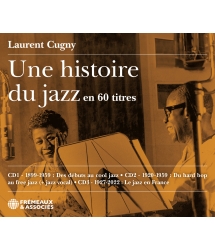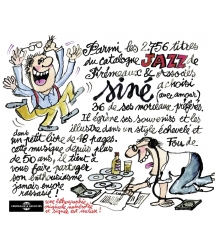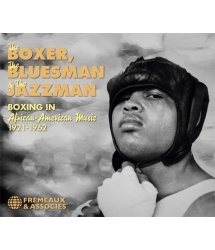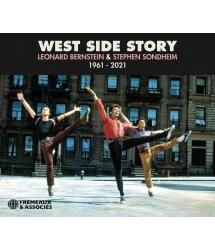- Notre Catalogue
- Philosophie
- Philosophes du XXème siècle et d'aujourd'hui
- Histoire de la philosophie (PUF)
- Contre-Histoire et Brève encyclopédie par Michel Onfray
- L'œuvre philosophique expliquée par Luc Ferry
- La pensée antique
- Les penseurs d'hier vus par les philosophes d'aujourd'hui
- Textes philosophiques historiques interprétés par de grands comédiens
- Histoire
- Livres
- Sciences Humaines
- Paroles historiques
- Livres audio & Littérature
- Notre Catalogue
- Jazz
- Blues - R'n'B - Soul - Gospel
- Rock - Country - Cajun
- Chanson française
- Musiques du monde
- Afrique
- France
- Québec / Canada
- Hawaï
- Antilles
- Caraïbes
- Cuba & Afro-cubain
- Mexique
- Amérique du Sud
- Tango
- Brésil
- Tzigane / Gypsy
- Fado / Portugal
- Flamenco / Espagne
- Yiddish / Israël
- Chine
- Tibet / Népal
- Asie
- Océan indien / Madagascar
- Japon
- Indonésie
- Océanie
- Inde
- Bangladesh
- URSS / Chants communistes
- Musiques du monde / Divers
- Musique classique
- Compositeurs - Musiques de film - B.O.
- Sons de la nature
- Notre Catalogue
- Jeunesse
- Philosophie
- Nouveautés
- Comment commander ?
- Recevoir le catalogue
- Manifeste
- Dictionnaire











- Notre Catalogue
- Philosophie
- Philosophes du XXème siècle et d'aujourd'hui
- Histoire de la philosophie (PUF)
- Contre-Histoire et Brève encyclopédie par Michel Onfray
- L'œuvre philosophique expliquée par Luc Ferry
- La pensée antique
- Les penseurs d'hier vus par les philosophes d'aujourd'hui
- Textes philosophiques historiques interprétés par de grands comédiens
- Histoire
- Livres
- Sciences Humaines
- Paroles historiques
- Livres audio & Littérature
- Notre Catalogue
- Jazz
- Blues - R'n'B - Soul - Gospel
- Rock - Country - Cajun
- Chanson française
- Musiques du monde
- Afrique
- France
- Québec / Canada
- Hawaï
- Antilles
- Caraïbes
- Cuba & Afro-cubain
- Mexique
- Amérique du Sud
- Tango
- Brésil
- Tzigane / Gypsy
- Fado / Portugal
- Flamenco / Espagne
- Yiddish / Israël
- Chine
- Tibet / Népal
- Asie
- Océan indien / Madagascar
- Japon
- Indonésie
- Océanie
- Inde
- Bangladesh
- URSS / Chants communistes
- Musiques du monde / Divers
- Musique classique
- Compositeurs - Musiques de film - B.O.
- Sons de la nature
- Notre Catalogue
- Jeunesse
- Philosophie
- Nouveautés
- Comment commander ?
- Recevoir le catalogue
- Manifeste
- Dictionnaire
BUNK JOHNSON, KID ORY, LOUIS ARMSTRONG, GEORGES LEWIS...
Ref.: FA5135
Direction Artistique : DAN VERNHETTES
Label : Frémeaux & Associés
Durée totale de l'œuvre : 2 heures 32 minutes
Nbre. CD : 2
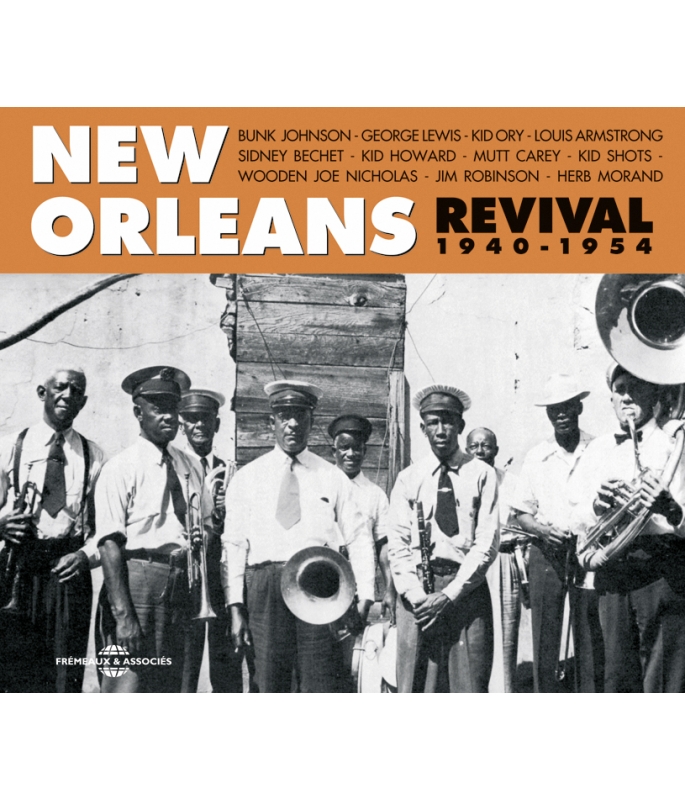
BUNK JOHNSON, KID ORY, LOUIS ARMSTRONG, GEORGES LEWIS...
- - * * * * JAZZMAN
- - RECOMMANDÉ PAR JAZZ NOTES
- - INDISPENSABLE JAZZ HOT
- - RECOMMANDÉ PAR JAZZ CLASSIQUE
Si la musique syncopée est jouée dans tous les Etats-Unis depuis le début du XXe siècle, c’est à la Nouvelle-Orléans que le swing est apparu. Le style unique de ses formations de jazz, devenu une véritable marque de fabrique, est une étape majeure dans l’histoire artistique américaine. Après la Deuxième Guerre mondiale, dans un élan de liberté et de quête du jazz des origines, l’Amérique redécouvre ce fleuron de son histoire. C’est l’époque du New Orleans “Revival” dont Dan Vernhettes nous permet de découvrir toute la richesse. Ce vaste panorama présente, à travers les plus grands interprètes, le “gumbo jazz” de la Nouvelle-Orléans : ragtimes, blues, marches, musique de danse, chansons légères ou rythmes religieux…
Patrick Frémeaux et Claude Colombini
Droits éditorialisation : Frémeaux & Associés Jazz - L'histoire sonore de notre mémoire collective à écouter.
Blues with Bechet With George Baquet & Sidney Bechet • Get it Right Kid Rena’s Delta Jazz Band • Panama Bunk Johnson Superior Band • Careless Love George Lewis and His New Orleans Stompers • Muskrat Ramble Kid Ory and his Creole Jazz Band • San Jacinto Stomp - Dumaine Street Drag With ‘Kid Shots’ & George Lewis • My Life Will Be Sweeter Someday Bunk Johnson’s Band • Creole Song Kid Ory’s Creole Jazz Band • Shake it and Break it - Eh la bas!Wooden Joe’s New Orleans Band • Milenberg Joys ‘Bunk’ Johnson, Sidney Bechet and their orchestra • Gloryland Bunk’s Brass Band • Over the Waves George Lewis Trio • Salutation March The Original Zenith Brass Band • I’ll Take You Home Again Kathleen With Bunk Johnson • Maryland My Maryland Louis Armstrong and His Dixieland Six • Snag it ‘Kid’ Ory and his Creole Jazz Band • Shim Sha Wabble - Chrysanthemum Mutt Carey and his New Yorkers • Les Ognons With Albert Nicholas • I Just Can’t Help Myself With Punch Miller • The Entertainer Bunk Johnson : Last Testament • Sheik Of Araby With Herb Morand • Jerusalem Blues George Lewis Jam Session • Streets of the City Paul Barbarin and his N.O. Band • Hindustan With Emile Barnes • West Lawn Dirge Eureka Brass Band • Ciribiribin The Louisiana Joymakers • St Louis blues Kid Thomas and his Algiers Stompers • When the Saints Go Marching in Oscar Celestin’s Tuxedo Jazz Band • See See Rider Kid Clayton’s Happy Pals • Blues in G With Emile Barnes • Down in Honky Tonk Town With Percy Humphrey • Milenberg Joys Freddie Kohlman and his Band • Cream. George Lewis and his Ragtime Band • Bsin Street Blues Jack Delaney and His N.O. Jazz Babies • Darktown Strutters Ball Lizzie Miles w/ George Lewis & his Ragtime Band • Lord Lord Lord You Sure Been Good to Me George Lewis & his Ragtime Band • Darktown Strutters Ball Kid Ory & his Creole Jazz Band • Somebody Else is Taking My Place - Just a Closer Walk With Thee George Lewis Band • High Society Oscar Celestin and his Tuxedo Jazz Band.
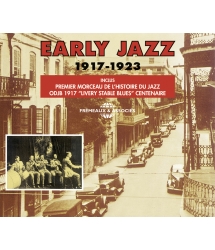
ANTHOLOGIE 1917 - 1923
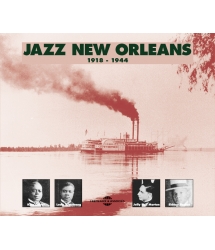
ANTHOLOGIE 1918-1944
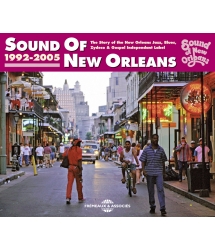
THE STORY OF THE NEW ORLEANS JAZZ, BLUES, ZYDECO &...




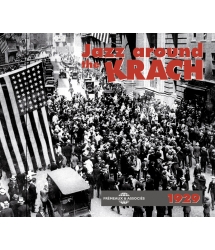
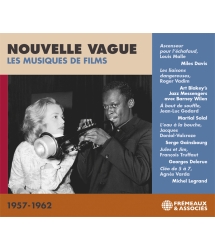
-
PisteTitreArtiste principalAuteurDuréeEnregistré en
-
1BLUES WITH BECHETGEORGE BAQUETSIDNEY BECHET00:03:391940
-
2GET IT RIGHTKID RENA S DELTA JAZZ BANDBOLDEN00:03:241940
-
3PANAMAJIM ROBINSONTYERS00:03:001942
-
4CARELESS LOVEJIM ROBINSONTRADITIONNEL00:03:321943
-
5MUSKRAT RAMBLEKID ORY AND HIS CREOLE JAZZ BANDKID ORY00:02:451944
-
6SAN JACINTO STOMPMADISON LOUIS KID SHOTSTRADITIONNEL00:04:061944
-
7DUMAINE STREET DRAGMADISON LOUIS KID SHOTSTRADITIONNEL00:04:371944
-
8MY LIFE WILL BE SWEETER SOMEDAYGEORGE LEWISTRADITIONNEL00:04:161944
-
9CREOLE SONGKID ORY AND HIS CREOLE JAZZ BANDKID ORY00:02:461944
-
10SHAKE IT AND BREAK ITWOODEN JOE S NEW ORLEANS BANDTRADITIONNEL00:03:361945
-
11EH LA BASWOODEN JOE S NEW ORLEANS BANDMC COBAN00:02:241945
-
12MILENBERG JOYSBUNK JOHNSON S JAZZ BANDMORTON00:04:191945
-
13GLORYLANDBUNK JOHNSON S JAZZ BANDTRADITIONNEL00:03:011945
-
14OVER THE WAVESGEORGE LEWISJUVENTINO ROSAS00:04:191945
-
15SALUTATION MARCHGEORGE LEWISSEITZ00:02:391946
-
16I LL TAKE YOU HOME AGAIN KATHLEENBUNK JOHNSONWESTENDORF00:03:141946
-
17MARYLAND MY MARYLANDDIXIELAND SIXRANDALL00:03:281946
-
18SNAG ITKID ORYOLIVER00:04:061947
-
19SHIM SHA WABBLEMUTT CAREY AND HIS NEW YORKERSSPENCER WILLIAMS00:02:571947
-
20CHRYSANTHEMUMMUTT CAREY AND HIS NEW YORKERSJOPLIN00:03:011947
-
21LES OGNONSPOPS FOSTERTRADITIONNEL00:03:041947
-
22I JUST CAN T HELP MYSELFPUNCH MILLERMILLER00:02:461947
-
PisteTitreArtiste principalAuteurDuréeEnregistré en
-
1THE ENTERTAINERBUNK JOHNSONJOPLIN00:03:001947
-
2SHEIK OF ARABYHERB MORANDWHEELER00:04:471949
-
3JERUSALEM BLUESGEORGE LEWIS JAM SESSIONTRADITIONNEL00:05:121950
-
4STREETS OF THE CITYPAUL BARBARIN AND NEW ORLEANS BANDTRADITIONNEL00:03:101950
-
5HINDUSTANEMILE BARNESWALLACE00:03:171951
-
6WEST LAWN DIRGEEUREKA BRASS BANDKING00:05:431951
-
7CIRIBIRIBINTHE LOUISIANA JOYMAKERSLAWRENCE00:02:241951
-
8ST LOUIS BLUESKID THOMAS AND ALGIERS STOMPERSCHRISTOPHER HANDY00:03:271951
-
9WHEN THE SAINTS GO MARCHING INO CELESTIN S TUXEDO JAZZ BANDTRADITIONNEL00:04:031951
-
10SEE SEE RIDERKID CLAYTON S HAPPY PALSTRADITIONNEL00:04:101952
-
11BLUES IN GEMILE BARNESTRADITIONNEL00:03:271952
-
12DOWN IN HONKY TONK TOWNPERCY HUMPHREYMC CARRON00:03:301952
-
13MILENBERG JOYSFREDDIE KOHLMAN AND HIS BANDMORTON00:03:281952
-
14ICE CREAMGEORGE LEWIS AND RAGTIME BANDB MOLL00:05:491953
-
15BASIN STREET BLUESNEW ORLEANS JAZZ BABIESWILLIAMS00:02:191953
-
16DARKTOWN STRUTTERS BALL 1GEORGE LEWIS AND RAGTIME BANDBROOKS00:02:051953
-
17LORD LORD LORD YOU SURE BEEN GOOD TO MEGEORGE LEWIS AND RAGTIME BANDTRADITIONNEL00:03:311954
-
18DARKTOWN STRUTTERS BALL 2KID ORY AND HIS CREOLE JAZZ BANDBROOKS00:03:311954
-
19SOMEBODY ELSE IS TAKING MY PLACEGEORGE LEWIS BANDHOWARD00:04:061954
-
20JUST A CLOSER WALK WITH THEEGEORGE LEWIS BANDTRADITIONNEL00:02:301954
-
21HIGH SOCIETYO CELESTIN S TUXEDO JAZZ BANDSTEELE00:03:551954
